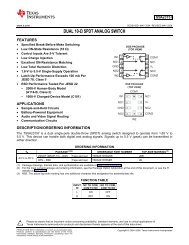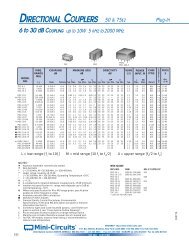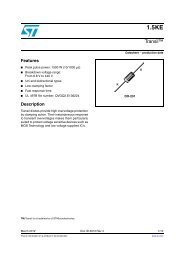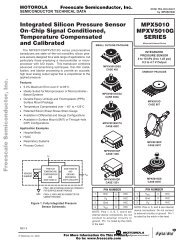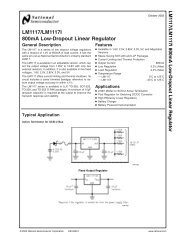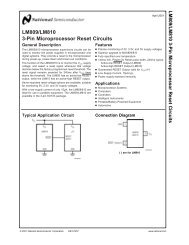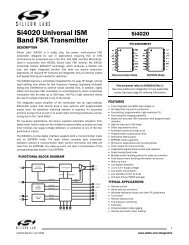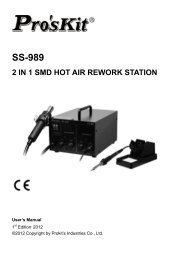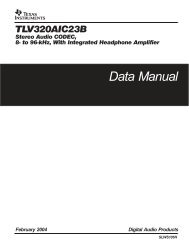Precision, Low Power Instrumentation Amplifier
Precision, Low Power Instrumentation Amplifier
Precision, Low Power Instrumentation Amplifier
You also want an ePaper? Increase the reach of your titles
YUMPU automatically turns print PDFs into web optimized ePapers that Google loves.
SINGLE SUPPLY OPERATIONThe INA118 can be used on single power supplies of +2.7Vto +36V. Figure 5 shows a basic single supply circuit. Theoutput Ref terminal is connected to ground. Zero differentialinput voltage will demand an output voltage of 0V (ground).Actual output voltage swing is limited to approximately35mV above ground, when the load is referred to ground asshown. The typical performance curve “Output Voltage vsOutput Current” shows how the output voltage swing varieswith output current.+ –With single supply operation, V IN and V IN must both be0.98V above ground for linear operation. You cannot, forinstance, connect the inverting input to ground and measurea voltage connected to the non-inverting input.To illustrate the issues affecting low voltage operation,consider the circuit in Figure 5. It shows the INA118,operating from a single 3V supply. A resistor in series withthe low side of the bridge assures that the bridge outputvoltage is within the common-mode range of the amplifier’sinputs. Refer to the typical performance curve “Input Common-ModeRange vs Output Voltage” for 3V single supplyoperation.INPUT PROTECTIONThe inputs of the INA118 are individually protected forvoltages up to ±40V. For example, a condition of –40V onone input and +40V on the other input will not causedamage. Internal circuitry on each input provides low seriesimpedance under normal signal conditions. To provideequivalent protection, series input resistors would contributeexcessive noise. If the input is overloaded, the protectioncircuitry limits the input current to a safe value of approximately1.5 to 5mA. The typical performance curve “InputBias Current vs Input Overload Voltage” shows this inputcurrent limit behavior. The inputs are protected even if thepower supplies are disconnected or turned off.INSIDE THE INA118Figure 1 shows a simplified representation of the INA118.The more detailed diagram shown here provides additionalinsight into its operation.Each input is protected by two FET transistors thatprovide a low series resistance under normal signal conditions,preserving excellent noise performance. Whenexcessive voltage is applied, these transistors limit inputcurrent to approximately 1.5 to 5mA.The differential input voltage is buffered by Q 1 and Q 2and impressed across R G , causing a signal current to flowthrough R G , R 1 and R 2 . The output difference amp, A 3 ,removes the common-mode component of the input signaland refers the output signal to the Ref terminal.Equations in the figure describe the output voltages of A 1and A 2 . The V BE and IR drop across R 1 and R 2 produceoutput voltages on A 1 and A 2 that are approximately 1Vlower than the input voltages.A 1 Out = V CM – V BE – (10µA • 25kΩ) – V O /2A 2 Out = V CM – V BE – (10µA • 25kΩ) + V O /2Output Swing Range A 1 , A 2 ; (V+) – 0.65V to (V–) + 0.06V<strong>Amplifier</strong> Linear Input Range: (V+) – 0.65V to (V–) + 0.98VC 1 C 2V CM V D /210µA V B 10µAInput Bias CurrentA 1A 2Compensation60kΩ60kΩ–V INQ 1R 1R 2Q 225kΩ25kΩV D /2R G(External)+ –V O = G • (V IN – V IN )Output Swing Range:(V+) – 0.8V to (V–) + 0.35V60kΩA 360kΩV ORef+V INFIGURE 4. INA118 Simplified Circuit Diagram.®INA11810



